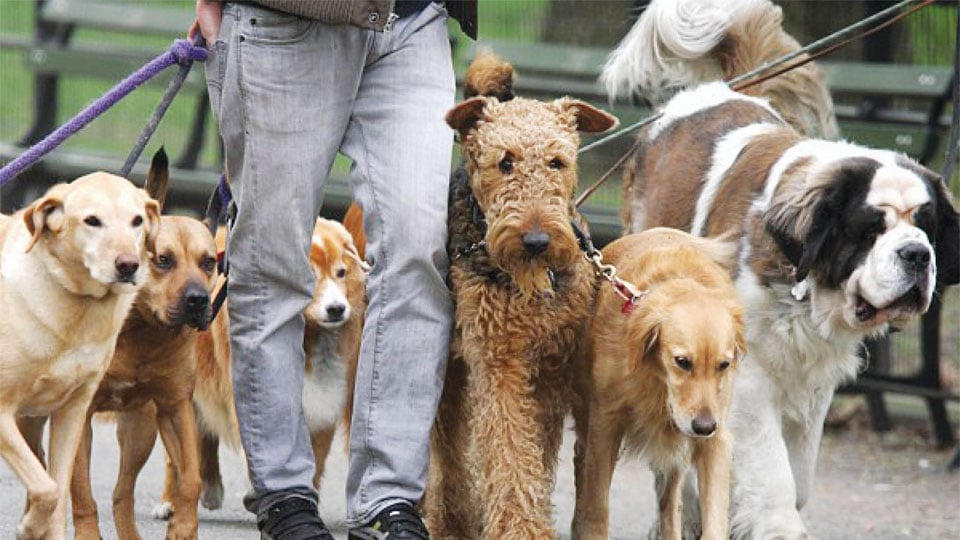In this week’s Pet Talk, Maneka speaks about Professional Dog Walker and how to stop a dog from chewing certain objects
The people who own the flat downstairs are never there. They live abroad and come back in the winter, three months later. They keep a dog who howls the whole day. He is taken out for a walk once a day by a temporary servant who comes in for an hour to feed and walk him. The rest of the time he is by himself. I feel very bad for him. Can I do something?
You can ask the servant if you can keep the dog with you. If he doesn’t agree, then get the e-mail id of this couple and write to them about keeping the dog. You should inform them that what they are doing to the dog amounts to cruelty and that the law doesn’t permit cruelty of this kind. Should they persist, they are likely to have a case against them and the dog taken away.
In my city, I have seen a person walking nine dogs at a time, early in the morning and again in the evening. Could they all belong to him?
This is probably a professional dog walker. It is an excellent way to earn extra pocket money. A number of people keep dogs but have no time or energy to walk them. If you offer this service, you could earn money as well save the dogs’ lives. Just remember to walk dogs who get on well with each other and not to walk them in the heat. Make sure you have fresh water with you. Also, keep a poop bag so that you can pick up their faeces and not litter your neighbourhood. Many young people all over the world do this.
My old dog seems to be perpetually hungry but it doesn’t seem to eat much from the two meals we give her.
Old dogs need to be fed many times a day in very small quantities. Give her softer food which is easier to chew and swallow.
Sometimes my dog sounds as if he is choking. He has a fit of reverse sneezing, when he pulls his nose in repeatedly and makes an odd sound?
Technically known as “paroxysmal respiration”, reverse sneezing can be caused by an irritant in the air, by eating or drinking too fast, by a foreign body or hair balls, or even a nasal infection. The resulting irritation of the palate or throat causes a spasm, resulting in quick inhalations of air into the dog’s nose. The trachea can narrow, causing difficulty in air movement. The condition is more common in older dogs. To reduce the chances of reverse sneezes, minimise chemicals, cleaners, rug deodorisers or other potential irritants from the home. Groom your dog often, and vacuum up hair every day. During a reverse sneeze, try rubbing your dog’s throat to ease the spasm. Very briefly cover his nose to encourage swallowing, which can dislodge a foreign body. Look into his mouth if need be, to see if anything is obstructing his throat. If so, remove it.
My three weeks old puppy has small pus-filled bumps on his abdomen and groin. What could be the reason?
Pus filled bumps are a sign of bacterial infections. The most common bacterial infection in pups is Impetigo. Impetigo pustules are very easy to rupture. They appear on the stomach and are filled with liquid. After bursting, they ooze and crust over, and cause discomfort and pain. At this stage, the impetigo is also very contagious, so any puppy or dog with it should be kept away from others until it clears up. Most impetigo clears up on its own, or dissipates with treatment.
A medicated shampoo can be used. Get one with benzoyl peroxide and bathe your puppy with it two times a week for 2 to 3 weeks. If the impetigo is not a mild enough case to clear up with only the use of topical treatments, you may need to obtain a round of oral antibiotics or topical antibiotic.
It could also be a sign of distemper. Canine distemper is a virus that affects a dog’s respiratory, gastrointestinal, and central nervous systems, as well as the conjunctival membranes of the eye. The first signs of canine distemper include abdominal pustules, sneezing, coughing and thick mucus coming from the eyes and nose. Fever, lethargy, sudden vomiting and diarrhoea, depression and/or loss of appetite are also symptoms of the virus. There is no cure for canine distemper.
Treatment for the disease, therefore, is heavily focused on alleviating the symptoms. If the animal has become anorexic or has diarrhoea, intravenous supportive fluids may be given. Discharge from the eyes and nose must be cleaned away regularly. Antibiotics may be prescribed to control the symptoms caused by a secondary bacterial infection, and phenobarbitals and potassium bromide may be needed to control convulsions and seizures. There are no antiviral drugs that are effective in treating the disease.
My dog gets exhausted very easily and his ears and tongue turn blue after a long run. What should I do?
These could be symptoms of a heart disease that could eventually lead to heart failure. A dog heart attack looks like this: Difficulty breathing which includes panting; Tilting of the head; Arrhythmia, pain and discomfort; Seizures or sudden collapse; Stiffness of the forelimbs.
Avoid administering any food or water during the attack. Due to the pain and discomfort associated with the heart attack, the dog may become aggressive. Pet owners should gently place a hand on the dog’s chest to determine the pace of heartbeat. Take the dog to a vet immediately and have all the tests done.
Three years ago, I took my 18-month-old female Pomeranian to the vet after a small scab came off her shoulder area. The hair has not only never grown back in that area but the spot has gotten larger. I can see tiny red spots around the perimeter of the hairless area.
The condition you are describing is focal alopecia, which is a localised area of hair loss on a dog. Pyotraumatic dermatitis, also known as “hot spots,” can leave such a characteristic lesion after they heal. Due to damage to the hair follicles during active inflammation, the hair may or may not grow back.
My concern is that you notice red spots around the edges of the lesion and that it is gradually increasing is size, which strongly suggests an active inflammatory response. Ringworm produces circular hairless lesions with a red ring, and should be ruled out by your regular veterinarian. Proper tests should be done to diagnose the disease correctly.
Treatment involves clipping the wound just past the red area so that the skin can be cleaned with a chlorhexidene solution and cool water, followed with topical application of an antimicrobial ointment or spray such as Vetericyn. Oral supplementation with omega fatty acids can also reduce the severity of chronic dermatoses.
My bulldog has broken out with these bumps around his mouth and chin. They look like little blisters. They don’t seem to hurt him but I’m still worried that he is allergic to something around the house?
This sounds like a fairly common ailment known as canine acne. In fact, bulldog is one of the breeds that is most affected by this complaint (as well as Boxers and Great Danes). This condition most commonly begins to develop at around the age of 5 to 8 months (equivalent to adolescence in humans).
Typically, the condition will resolve itself after about one year of age — and if chronic acne still persists, veterinary care may be required. Keeping the skin around affected areas clean with mild anti-bacterial cleanses will help to control outbreaks and prevent infection. Anti-inflammatories are only generally required if your dog is scratching the affected area more than is healthy for the skin. I would still recommend that your dog sees a vet, who may decide to take a skin biopsy to be sure that acne is the cause. Other possible reasons for these symptoms include ringworm and demodecosis (a mite infestation).
How can I stop my dog from chewing and swallowing certain objects?
Just like the inclusion of a new family member involves the process of telling, explaining or teaching (in case of a baby) them the rules of living in a particular family, the dogs also need to be trained not to chew on household stuff, like furniture or bottles. They are taught in initial stage by pulling away the object and, instead, handing them their calcium bone or teether. A “no” command if taught, helps. The dogs have the tendency to chew on things out of anxiety or anger, or simply when the teeth are still growing they have a craving to bite or chew.








Recent Comments